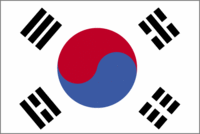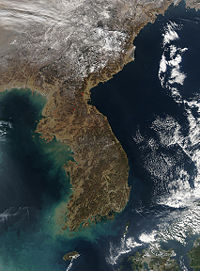South Korea: Difference between revisions
imported>Chunbum Park |
imported>Chunbum Park |
||
| Line 7: | Line 7: | ||
{{Image|Korean peninsula.jpg|right|200px|A satellite image of the Korean peninsula.}} | {{Image|Korean peninsula.jpg|right|200px|A satellite image of the Korean peninsula.}} | ||
=== Physical constituency === | === Physical constituency === | ||
South Korea covers a total of 99,678 km<sup>2</sup> (38,328 mi<sup>2</sup>) over | South Korea covers a total of 99,678 km<sup>2</sup> (38,328 mi<sup>2</sup>) over 8 mainland provinces, the island of [[Jejudo]], and about 3,000 smaller islands appearing mostly on the western side of the peninsula. South Korea's only physical border lies across the [[38th Parallel]], which originally divided the Korean peninsula but was replaced as a result of the Korean War. | ||
== Politics == | == Politics == | ||
Revision as of 19:09, 10 November 2008
South Korea, officially the Republic of Korea or ROK (Korean: Namhan; Daehan Min-guk[1]),[2] is a constitutional republic comprising the southern part of Korea, which protrudes southward from the Northeastern Asian mainland and lies between the Yellow Sea and the Sea of Japan (East Sea). Its East Asian neighbors include China, Taiwan, and Japan, which share strong historical and cultural ties with Korea. When South Korea was established in 1948 after the end of Japanese colonial rule, the country was one of the poorest in the world, and its economic prospect worsened with destruction of the nation's infrastructure during the Korean War from 1950 to 1953. However, during the the early 1960s and the two decades that followed, South Korea transformed its largely agricultural economy into a modern industrial power and has currently the 13th largest GDP. Seoul is the capital of South Korea, and it is also the world's second largest city and a major technological and financial hub for the region. The country's current president is Yi Myungbak, who assumed office in February, 2008.
Geography
Physical constituency
South Korea covers a total of 99,678 km2 (38,328 mi2) over 8 mainland provinces, the island of Jejudo, and about 3,000 smaller islands appearing mostly on the western side of the peninsula. South Korea's only physical border lies across the 38th Parallel, which originally divided the Korean peninsula but was replaced as a result of the Korean War.
Politics
Economy
Demography
History
Footnotes
- ↑ i.e. 'Great Nation of the People of Korea'
- ↑ According to the revised romanization of Korean.


